
The William Shelly School and Annex, also known as the Eberton School, is a historic school building and annex located in West York, York County, Pennsylvania. Built circa 1897, the Shelly Annex was initially designed as a one-room school, but was then enlarged twice between 1898 and 1903 to become a 2 1/2-story, gable roofed brick building which is three bays wide and seven bays deep. Built between 1905 and 1908, the Shelly School was designed in the Italian Renaissance style, and is a two-story brick structure which is nine bays wide and seven bays deep. Completely rebuilt following a fire in 1919, the property was sold in 1960; the buildings were then utilized as storage facilities for the next 37 years.

Spring Grove Farm and Distillery is a historic farm complex and distillery site located at Antrim Township in Franklin County, Pennsylvania, USA. The house was built in 1867, and is a two-story, "T"-shaped, brick dwelling in the Greek Revival style. Also on the property are a contributing two-story, four bay brick building believed to have housed a cooper's shop and residence, brick summer kitchen, brick smoke house, frame pumphouse, large brick end bank barn with a slate roof, frame wagon shed, brick carriage house, stone mill (1803) and the site of the Spring Grove Distillery. The distiller ceased to operate in 1920.
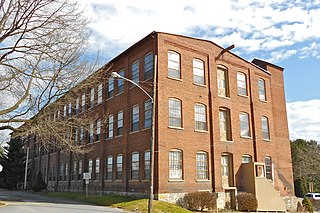
Ashley and Bailey Silk Mill is a historic silk mill located at Marietta, Lancaster County, Pennsylvania. It was built in 1897, and is a three-story brick factory building on a limestone foundation. It is 13 bays long and has a low-pitched gable roof. Currently, the structure is used as condominiums.

Haines Mill, also known as Haines Mill Museum, is a historic grist mill located at South Whitehall Township, Lehigh County, Pennsylvania. It was built about 1840, and is a four-story, stone building with a slate covered gambrel roof. It is three bay by three bay, 42 feet by 46 feet, 9 inches. The interior was rebuilt after a disastrous fire in 1908. A three-story brick addition was built in 1930, with a lean-to roof. Atop the main roof is a cupola. It remained in full operation until 1957. Today, Haines Mill is operated as a partnership between the County of Lehigh, which owns and maintains the site, and the Lehigh County Historical Society, which provides public tours.

Globe Knitting Mills, also known as the Rambo & Regar Globe Knitting Mills, are two historic textile mill buildings located at Norristown, Montgomery County, Pennsylvania. They were built in 1898, and were referred to as the "Main (Knitting) Building" and the "Oxidizing Building / Dye House." They are constructed of red brick with heavy timber framing and Italianate style design elements. The main building is three stories tall and rectangular in plan.

John Marshall Elementary School is a historic elementary school located in the Frankford neighborhood of Philadelphia, Pennsylvania. It is part of the School District of Philadelphia. The building was designed by Henry deCourcy Richards and built in 1909–1910. It is a three-story, five-bay by three-bay, brick building on a raised basement in the Colonial Revival style. It has a three-story, rear brick addition built in 1922. It features a pedimented cornice, brick parapet, projecting central section, and a two-story arched opening above the main entrance. The school was named for Chief Justice John Marshall.

Cedar Grove Christian Academy is a private Christian school located in the Lawndale neighborhood of Philadelphia, Pennsylvania. It is located in the former Lawndale School building. The school was built in 1903–1904, and is a two-story, three-bay, stone-faced brick building in the Colonial Revival style. Two two-story wings designed by Irwin T. Catharine were added in the 1920s. It features heavy stone sills and lintels and a crenellated parapet.

David Landreth School is a historic school building located in the Point Breeze neighborhood of Philadelphia, Pennsylvania. It was built in 1889 after the original school caught fire.
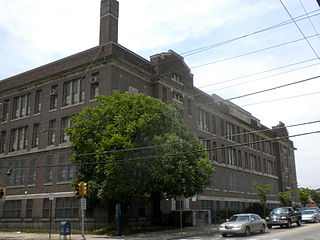
John M. Patterson School is a historic elementary school located in the Penrose neighborhood of Philadelphia, Pennsylvania. It is part of the School District of Philadelphia The building was designed by Irwin T. Catharine and built in 1920–1921. It is a three-story, eight bay by three bay, brick building on a raised stone basement in the Colonial Revival-style. It features a large center entrance, stone coping, and a parapet.

Rudolph Blankenburg School is a historic school located in the Mill Creek neighborhood of Philadelphia, Pennsylvania. It is part of the School District of Philadelphia. It is named in honor of Rudolph Blankenburg, who was mayor of Philadelphia between 1911 and 1915. The building was designed by Irwin T. Catharine and built in 1923–1925. It is a three-story, nine bay by five bay, brick building on a raised basement in the Colonial Revival style. It features large stone arch surrounds on the first level, a projecting entrance pavilion, a double stone cornice, and brick parapet topped by stone coping.

Nicholas Johnson Mill, also known as Schollenberger Mill, is a historic grist mill located in Colebrookdale Township, Berks County, Pennsylvania. The mill was built in 1861, and is a 2 1⁄2-story, plus basement, brick building on a stone foundation. It measures 36 feet by 40 feet and is three bays wide and four bays deep. Also on the property are a 2 1⁄2-story, brick farmhouse built in 1838; a Switzer bank barn built about 1850; stone and log tenant house from the early 1800s; and some elements of the water power system.
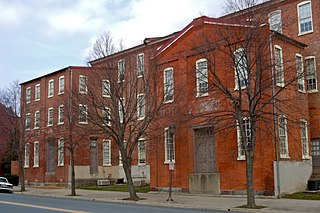
Hendel Brothers, Sons and Company Hat Factory, also known as "The Hat Factory," is a historic factory building located in Reading, Berks County, Pennsylvania. The original section was built about 1850, as a woolen mill. It is a three-story, brick building with the central section measuring 62 feet by 130 feet. It has a three-story south wing, two-story north wing, and small two-story west wing. It is of heavy timber frame construction, and features large arched double hung windows. A hat factory operated in the building until about 1930, after which it was used as a warehouse and trucking terminal.
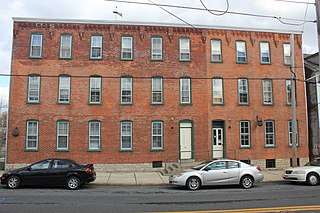
H.K. Deisher Knitting Mill is a historic factory building located at Kutztown, Berks County, Pennsylvania. The original section was built in 1881, with the third story added in 1903 and addition in 1907. A loading dock was added in the 1950s. It is a three-story, "L"-shaped red brick building on a limestone foundation. It has a low pitched gable roof topped by a weathervane. It was used as a knitting mill until 1956, after which it was used as a warehouse.
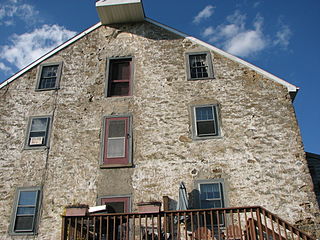
There are two historic mills called Warwick Mills. The older of the two is in Pennsylvania and is no longer running. The other is in New Hampshire, and is still manufacturing today.

Armstrong Knitting Factory is a historic silk mill located at Charlottesville, Virginia. It was built in 1889, and is a two-story, 11 bay, rectangular brick building with a low hipped roof. It has a central entrance tower with a mansard roof in the Second Empire style.

The Busiel-Seeburg Mill is a historic mill building in Laconia, New Hampshire, since converted into an office building known as 1 Mill Plaza. This 3-1/2 story brick structure achieved its present configuration in stages, beginning in 1853, and successively altered and expanded through the rest of the 19th century. The business, established by John W. Busiel in 1846, manufactured knitted hosiery, and was one of the first producers of knitwear to use circular knitting machines invented by Aiken and Peppers. The building was listed on the National Register of Historic Places in 1971.
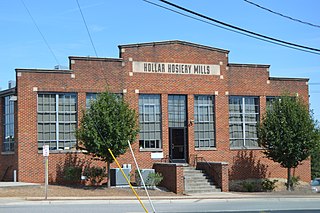
Hollar Hosiery Mills-Knit Sox Knitting Mills is a historic knitting mill located at Hickory, Catawba County, North Carolina. It consists of two mill brick manufacturing buildings and a boiler house that were connected by a hyphen in the mid-1960s. The first mill building was built about 1930, and is a one- to two-story, 16 bay, brick veneer structure. The boiler house was also built about 1930, and is a small, brick building, with its flat roof and terra cotta coping. The hosiery yarn mill was built about 1940, and is two-story, six bay by 10 bay, brick-veneered building. Both mill buildings feature banks of steel-sash factory windows. The knitting mill operated until 1968.

P.H. Hanes Knitting Company is a historic textile mill complex located at Winston-Salem, Forsyth County, North Carolina. The complex includes three buildings. The Knitting Building or North Building was built in 1920–1921, and is a six-story, Beaux-Arts style concrete and steel building sheathed in brick. The Mill Building or East Building was built in 1928, and is a five-story-plus-basement building of concrete, brick, and steel construction. The Warehouse and Shipping Building was built in 1940, and is a six-story steel frame building sheathed in brick. The P.H. Hanes Knitting Company was founded in 1901 by Pleasant H. Hanes, brother of John W. Hanes who founded Shamrock Mills, later Hanes Hosiery. In February 1965, P. H. Hanes Knitting Company merged with Hanes Hosiery. The downtown mill complex closed in 1965. The complex has been converted to loft apartments.

West Brothers Knitting Company is a historic knitting mill located in the Westside neighborhood of Syracuse, Onondaga County, New York. West Brothers was built in 1906–1907, and is a three-story, 20 bay by 6 bay, red brick mill building with a raised basement. It is of standard mill construction. The front facade features a three-bay, four-story elevator tower. The West Knitting Corporation moved to Wadesboro, North Carolina in 1928. The mill later housed a corrugated paper container manufacturer, the Gray Brothers Boot & Shoe Manufacturing Company, and most recently a manufacturer of a wide variety of air filters.

The Western Knitting Mills is a former industrial building located at 400 Water Street in Rochester, Michigan. The building has been renovated to serve commercial tenants, including Rochester Mills Beer Company. It was listed on the National Register of Historic Places in 2000.
























